Research on Deformation of Hydraulic Cylinders Made of Plastics
Abstract
:1. Introduction
- -
- Computer simulations of stress and strain carried out using FEM;
- -
- Experimental research of deformations using a special test stand.
2. Computer Simulations Using FEM
2.1. Objects of Research and Their Models
- -
- The smaller cylinder with a diameter Ø = 30 mm and a stroke S = 200 mm designed for small-sized systems and nominal working pressure p = 6.3 MPa;
- -
- The larger cylinder with a diameter Ø = 50 mm and a stroke S = 200 mm intended for medium-sized systems (mass) and nominal working pressure p = 6.3 MPa.
- -
- Hydraulic loads (1) with working pressure acting on the channels in the bottom cap and the bottom chamber (under-piston chamber) in the cylinder’s tube, or on the channels in the gland cap and the gland chamber (over-piston chamber) in the cylinder’s tube;
- -
- Mechanical loads (2) acting on the piston rod along its axis, in the direction opposite to the movement of piston rod.
2.2. Simulation Results and Discussion
3. Experimental Research
3.1. Research Stand and Method of Testing
3.2. Research Results and Discussion
4. Summary and Conclusions
- Stress values in the key elements of the cylinders made of plastic, which are loaded with pressure p = 6.3 MPa and force F = 4.45 kN (Ø = 30 mm) and F = 12.36 kN (Ø = 50 mm), are lower than the values of allowable stresses. The highest stress values occur in the cylinder tubes and reach values shown in equation (2) for the cylinder of internal diameter Ø = 30 mm and Equation (3) for cylinder of internal diameter Ø = 50 mm.σØ30 = 23.5 MPa < σallow = 30 MPaσØ50 = 20.5 MPa < σallow = 30 MPa
- Local deformations of the cylinder tube causing the increase in its diameter are shown in Equation (4) for cylinder of internal diameter Ø = 30 mm and Equation (5) for cylinder of internal diameter Ø = 50 mm.ΔdØ30 = 0.45 mmΔdØ50 = 0.50 mm
Funding
Acknowledgments
Conflicts of Interest
References
- Li, Y. Review and Challenges of Lightweight Composite Hydraulic Cylinder. JMechE 2021, 57, 13–38. [Google Scholar] [CrossRef]
- Lubecki, M.; Stosiak, M.; Skačkauskas, P.; Karpenko, M.; Deptuła, A.; Urbanowicz, K. Development of Composite Hydraulic Actuators: A Review. Actuators 2022, 11, 365. [Google Scholar] [CrossRef]
- Solazzi, L. Design and experimental tests on hydraulic actuator made of composite material. Compos. Struct. 2019, 232, 111544. [Google Scholar] [CrossRef]
- Mantovani, S. Feasibility Analysis of a Double-Acting Composite Cylinder in High-Pressure Loading Conditions for Fluid Power Applications. Appl. Sci. 2020, 10, 826. [Google Scholar] [CrossRef] [Green Version]
- Błażejewski, W. Composite Pressure Vessels Reinforced with Fibers according to Mosaic Patterns; Oficyna Wydawnicza Politechniki Wrocławskiej: Wrocław, Poland, 2013. [Google Scholar]
- Stryczek, P. A Method of Designing Hydraulic Cylinders Made of Plastics; Raporty Wydziału Mechanicznego Politechniki Wrocławskiej: Wrocław, Poland, 2022; Ser. PRE; nr 20. 143 s. [Google Scholar]
- Kujawa, M.; Kowalewski, P.; Wieleba, W. The Influence of Deformation under Tension on Some Mechanical and Tribological Properties of High-Density Polyethylene. Polymers 2019, 11, 1429. [Google Scholar] [CrossRef] [Green Version]
- Rodionov, L.; Stryczek, J.; Rekadze, P.; Gafurov, S.; Prokofiev, A.; Shakhmatov, E. Challenges in design process of gear micropump from plastics. Arch. Civ. Mech. Eng. 2021, 21, 1–14. [Google Scholar] [CrossRef]
- Stryczek, J.; Antoniak, P.; Jakhno, O.; Kostyuk, D.; Kryuchkov, A.; Belov, G.; Rodionov, L. Visualisation research of the flow processes in the outlet chamber–outlet bridge–inlet chamber zone of the gear pumps. Arch. Civ. Mech. Eng. 2015, 15, 95–108. [Google Scholar] [CrossRef]
- Krawczyk, J.; Stryczek, J. Design and Experimental Research of a Plastic Gerotor Pump. In Proceedings of the Global Fluid Power Society PhD Symposium (GFPS), Samara, Russia, 18–20 July 2018. [Google Scholar]
- Banaś, M.; Antoniak, P.; Marciniak, L.; Stryczek, J. Visualization of flow phenomena in hydraulic throttle valves of plastics. In Proceedings of the 14th International Conference on Vibration Engineering and Technology of Machinery (VETOMAC XIV), Lisbon, Portugal, 10–13 September 2018. [Google Scholar]
- Stryczek, P.; Przystupa, F.W.; Banaś, M. Design and research on a hydraulic cylinder with plastic components. In Proceedings of the ASME 2016 9th FPNI Ph.D. Symposium on Fluid Power, Florianópolis, SC, Brazil, 26–28 October 2016. [Google Scholar]
- Zienkiewicz, O.C. Finite Element Metod; Arkady: Warszawa, Poland, 1972. [Google Scholar]
- Rusiński, E.; Czmochowski, J.; Smolnicki, T. Advanced Finite Element Method in the Load-Bearing Structures; Oficyna Wydawnicza Politechniki Wrocławskiej: Wrocław, Poland, 2000. [Google Scholar]
- Banaś, M. Internal Leakages in a Water Hydraulic Pump with Gears From Plastic. Int. J. Fluid Power 2021, 21, 347–362. [Google Scholar] [CrossRef]
- Kim, A.; Dudkin, M.; Valiov, A.; Gurianov, G. New vibroscreen with additional feed elements. Arch. Civ. Mech. Eng. 2017, 17, 786–794. [Google Scholar] [CrossRef]
- Milojević, S.; Savić, S.; Marić, D.; Stopka, O.; Krstić, B.; Stojanović, B. Correlation between Emission and Combustion Characteristics with the Compression Ratio and Fuel Injection Timing in Tribologically Optimized Diesel Engine. Tehnicki Vjesnik 2022, 29, 1210–1219. [Google Scholar] [CrossRef]
- Goljat, S.; Tič, V.; Lovrec, D. Prevention of Water Ingress in Hydraulic Systems. Appl. Eng. Lett. J. Eng. Appl. Sci. 2021, 6, 99–104. [Google Scholar] [CrossRef]

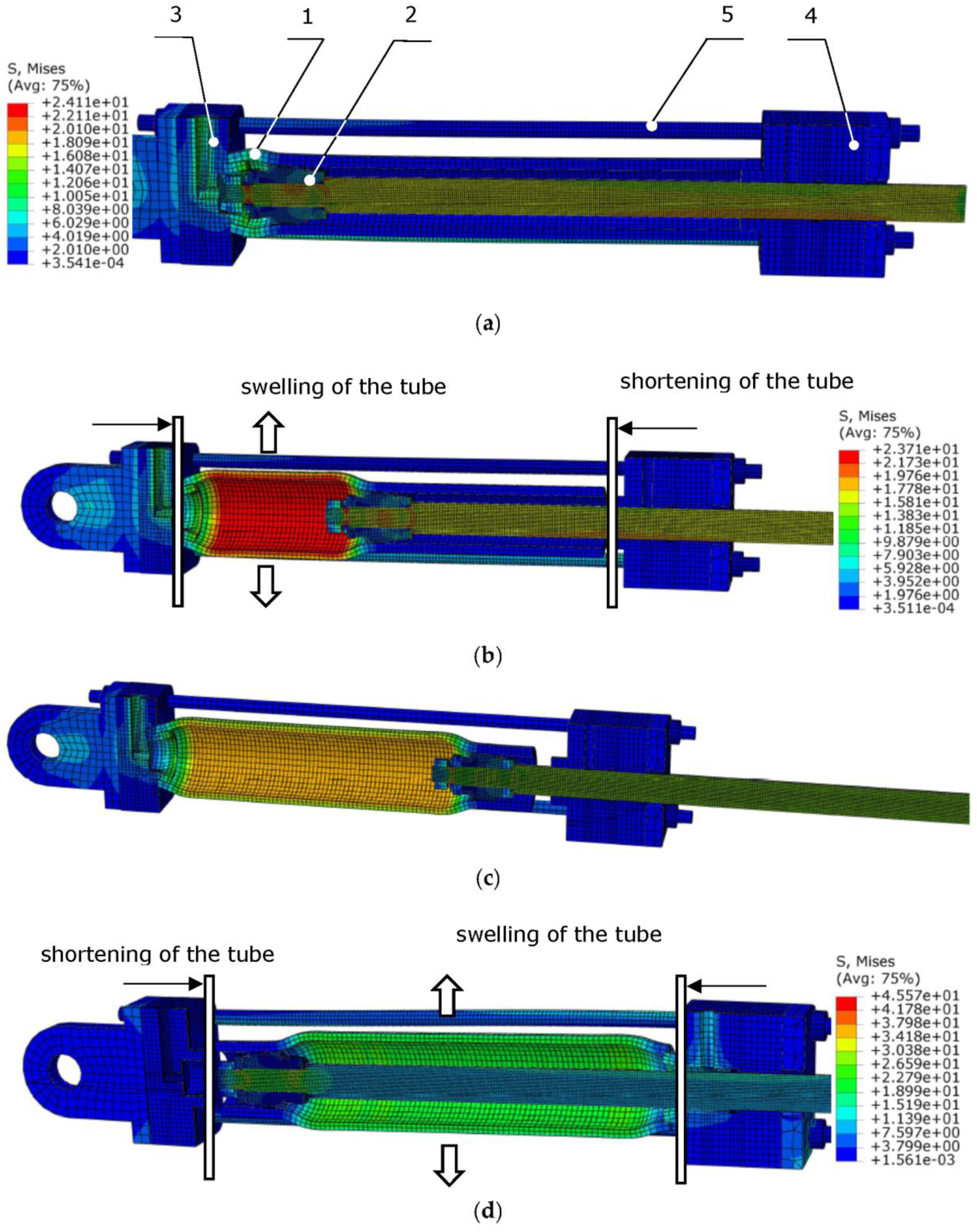
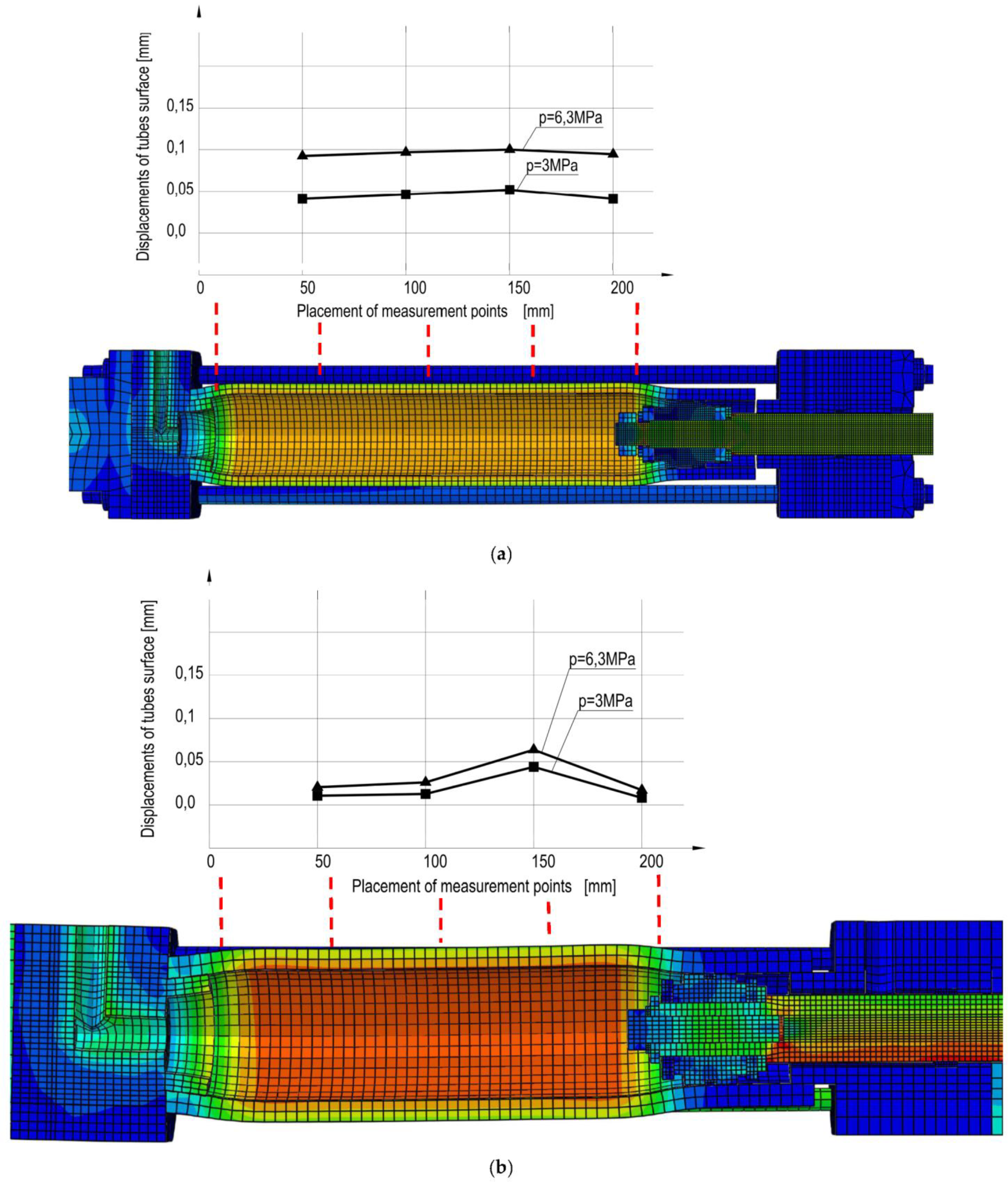

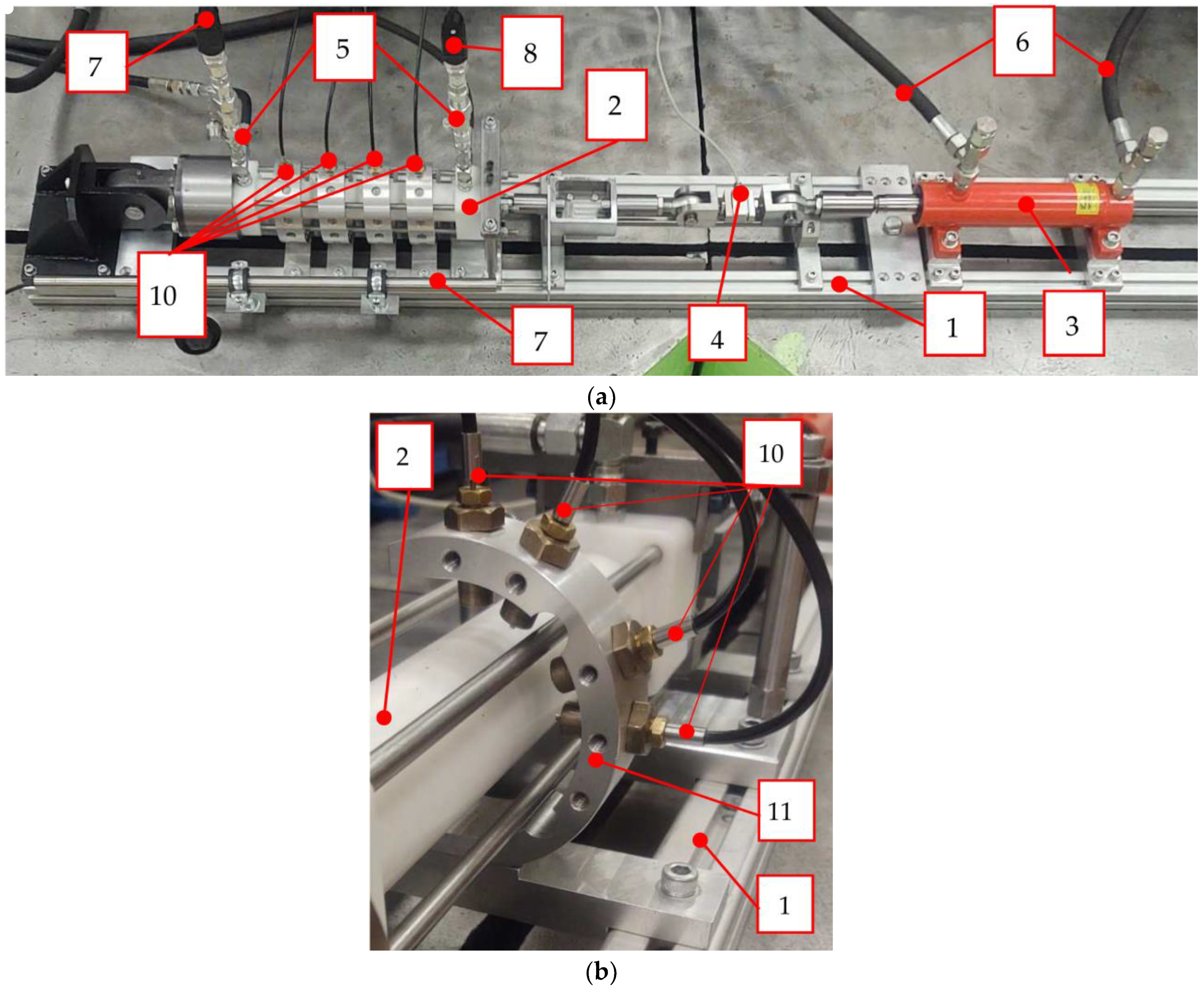
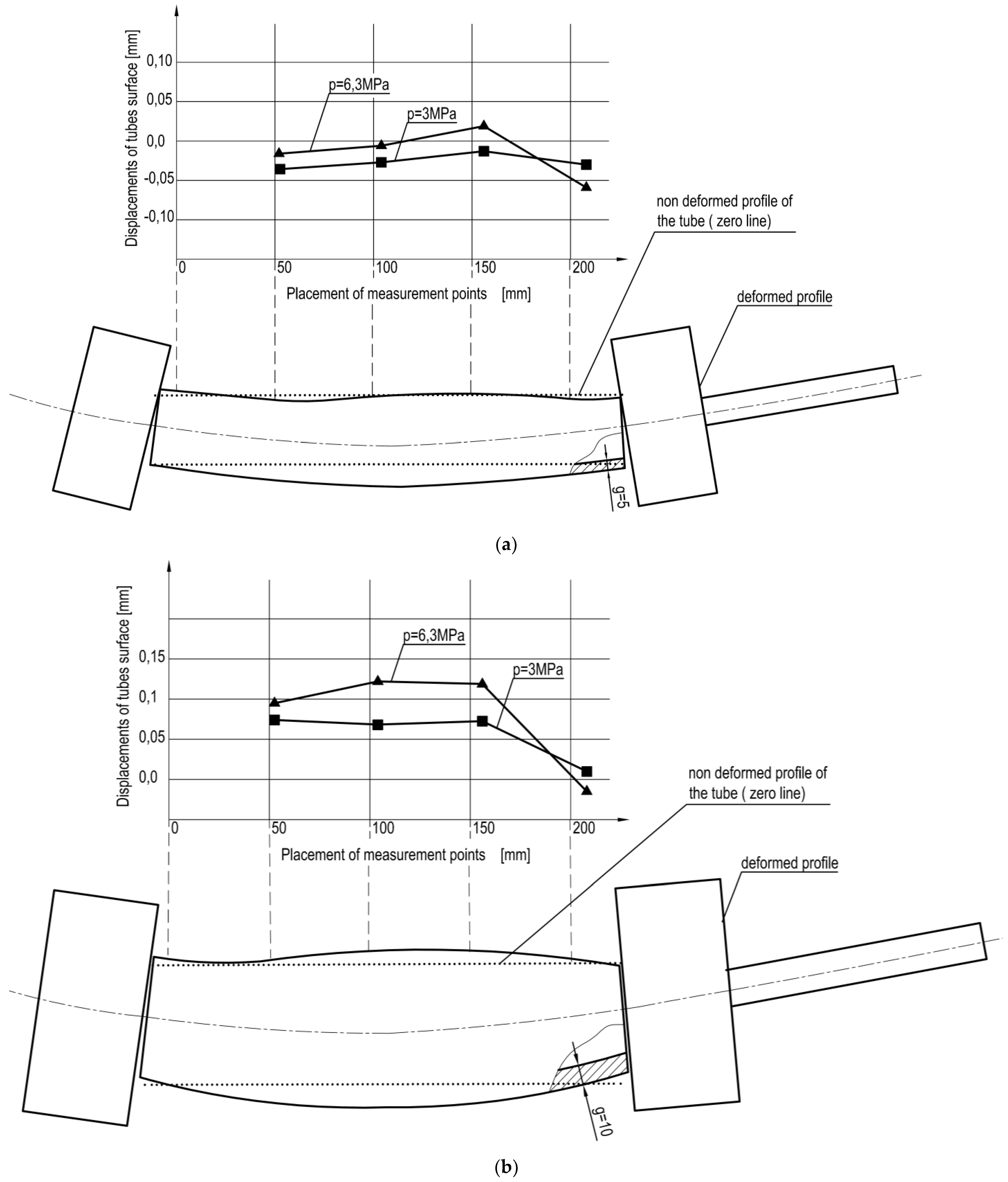
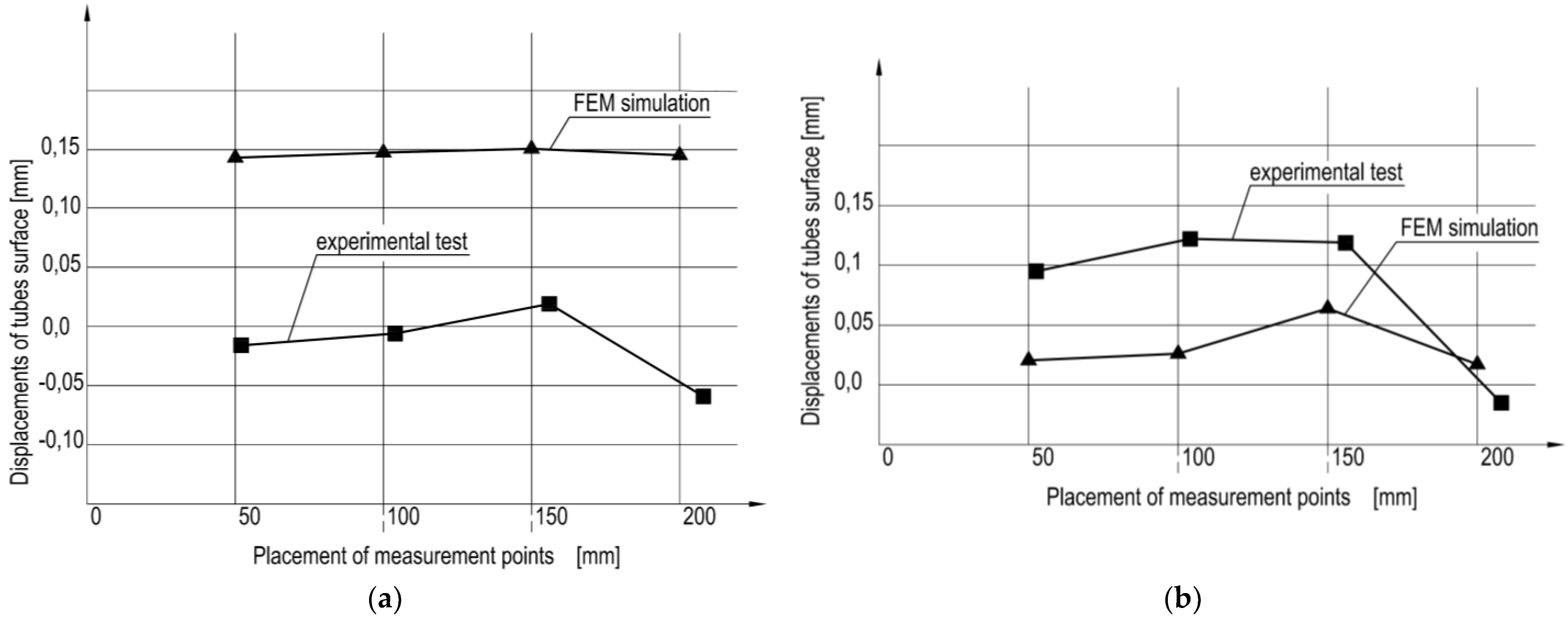
| No. | Part | Load (MPa), (kN) | Maximum Stress (MPa) | Allowable Stress (MPa) | Maximum Strain (mm) |
|---|---|---|---|---|---|
| cylinder Ø30 mm, S = 200 mm | |||||
| 1 | Tube | 6.3 (MPa) 4.45 (kN) | 23.5 | 30 | 0.45 |
| 2 | Piston | 28.4 | 0.48 | ||
| 3 | Bottom cap | 15.7 | 0.09 | ||
| 4 | Gland cap | 16.4 | 0.1 | ||
| 5 | Tie rods | 20.2 | 0.04 | ||
| cylinder Ø50 mm, S = 200 mm | |||||
| 1 | Tube | 6.3 (MPa) 12.36 (kN) | 20.5 | 30 | 0.50 |
| 2 | Piston | 27.9 | 0.52 | ||
| 3 | Bottom cap | 17.5 | 0.27 | ||
| 4 | Gland cap | 20.,3 | 0.2 | ||
| 5 | Tie rods | 15.6 | 0.9 | ||
Disclaimer/Publisher’s Note: The statements, opinions and data contained in all publications are solely those of the individual author(s) and contributor(s) and not of MDPI and/or the editor(s). MDPI and/or the editor(s) disclaim responsibility for any injury to people or property resulting from any ideas, methods, instructions or products referred to in the content. |
© 2023 by the author. Licensee MDPI, Basel, Switzerland. This article is an open access article distributed under the terms and conditions of the Creative Commons Attribution (CC BY) license (https://creativecommons.org/licenses/by/4.0/).
Share and Cite
Stryczek, P. Research on Deformation of Hydraulic Cylinders Made of Plastics. Energies 2023, 16, 5708. https://doi.org/10.3390/en16155708
Stryczek P. Research on Deformation of Hydraulic Cylinders Made of Plastics. Energies. 2023; 16(15):5708. https://doi.org/10.3390/en16155708
Chicago/Turabian StyleStryczek, Piotr. 2023. "Research on Deformation of Hydraulic Cylinders Made of Plastics" Energies 16, no. 15: 5708. https://doi.org/10.3390/en16155708




